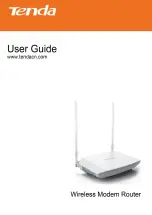
60
Appendix III- Advanced Settings
This section provides more detail explanation on advanced setting for routing and wireless
settings.
The Advanced options page allows the user to manage advanced settings that influence
on the device performance and behavior. The advanced wireless settings are dedicated
for more technically advanced users who have a sufficient knowledge about wireless LAN
technology.
Advanced Wireless Setting
The 802.11a/g data rates include 6, 9, 12, 18, 24, 36, 48, 54Mbps.
The 802.11n data rates are the MCS (Modulation Coding Scheme ) rates.
MCS0 to MCS7
are 802.11n rates, which uses only 1 Tx/Rx stream.
MCS8 to MCS15
are 802.11n rates, which uses 2 Tx/Rx streams.
The Rate Algorithm has a critical impact on performance in outdoor links as generally
lower data rates are more immune to noise while higher rates are less immune, but are
capable of higher throughput.
Noise Immunity
option increases the robustness of the device to operate in the presence
of noise disturbance which is usually generated by external 802.11 traffic sources,
channel hopping signals and other interferes.
RTS Threshold:
determines the packet size of a transmission and, through the use of an
access point, helps control traffic flow. The range is 0-
2347bytes, or word “off”. The default
value is 2347 which means that RTS is disabled.
RTS/CTS (Request to Send / Clear to Send) is the mechanism used by the 802.11
wireless networking protocol to reduce frame collisions introduced by the hidden terminal
problem. RTS/CTS packet size threshold is 0-2347 bytes. If the packet size the node
wants to transmit is larger than the threshold, the RTS/CTS handshake gets triggered. If
the packet size is equal to or less than threshold the data frame gets sent immediately.
System uses Request to Send/Clear to send frames for the handshake which provide
collision reduction for access point with hidden stations. The stations are sending a RTS
frame first while data is send only after handshake with an AP is completed. Stations
respond with the CTS frame to the RTS which provides clear media for the requesting
station to send the data. CTS collision control management has time interval defined
during which all the other stations hold off the transmission and wait until the requesting
station will finish transmission.
Fragmentation Threshold:
specifies the maximum size for a packet before data is
fragmented into multiple packets. The range is 256-
2346 bytes, or word “off”. Setting the
Fragmentation Threshold too low may result in poor network performance.
The use of fragmentation can increase the reliability of frame transmissions. Because of
sending smaller frames, collisions are much less likely to occur. However lower values of
the Fragmentation Threshold will result lower throughput as well. Minor or no
modifications of the Fragmentation Threshold value is recommended while default setting
of 2346 is optimum in most of the wireless network use cases.
Содержание APX-110N5
Страница 24: ...24 ...
Страница 65: ...65 Appendix V VLAN Setup examples A Tagged Wireless VLAN to Tagged Ethernet VLAN Setup ...









































